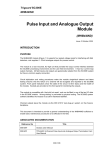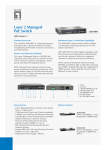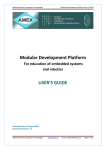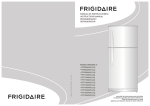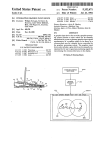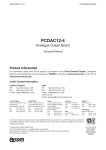Download Processor Module
Transcript
Triguard SC300E MPP Processor Module (MPP) Issue 6 October 2005 Three MPPs are fitted in the three right hand slots of the main chassis. They provide a central processing facility for the Triguard SC300E system. Operation of the system is software controlled by the Real Time Task Supervisor (RTTS) which continuously executes the following functions: • Polling of inputs and outputs • Diagnostics to detect internal faults, power outages, voting agreement and the health of the processor module microprocessor • Tracking of maintenance activities such as hot repair • Detection of latent faults in I/O modules • Execution of safety and control logic • Data acquisition and Sequence Of Events (SOE) for transmission to an operator workstation 008-5100 Triguard SC300E Switch S1 Switch S2 Diagnostic port Connector J1 Connector J2 Microprocessor 80486DX Keyswitch Back up batteries Figure 1-1 MPP General view and front panel detail 2 MPP October 2005 – Issue 6 Triguard SC300E MPP Processor Module ASSOCIATED DOCUMENTATION Reference No Title 008-5097 Chassis User Manual 008-5105 MBB Bus Extender Module User Manual 008-5115 TBA Bus Expansion Adaptor User Manual 008-5217 TBT Bus Terminator User Manual SPECIFICATION Model MPP Processor Intel family EPROM 1 Mbyte fitted RAM 1 Mbyte fitted RAM backup battery (optional) Lithium battery, shelf life 8 to 10 years (program holdup 6 months) (Spares available) Inter processor communication Serial high speed, read only Diagnostic port For factory testing purposes 4 position keyswitch On Line, Program, Test, Reset Indicators Run, On Line, Program, Test, Health, I/O Scan, Battery, Communications Module power consumption 10W Overall size (mm) 400(9U)H x 397L x 28W Overall size (inches) 15.75H x 15.63L x 1.1W MPP October 2005 – Issue 6 3 Triguard SC300E Environmental specifications The maximum ambient temperature measured at the hottest point within the Triguard system shall not be greater than 60 degrees centigrade. Temperature operating: +5°C to 60°C Temperature storage: -25°C to +70°C Humidity 5% to 95% non-condensing at ambient <40°C EMC/RFI Immunity Tested and certified to IEC 1131-Part 2 1994 Vibration/Shock Tested and certified to IEC 1131-Part 2 1994 Certification: General Certification: Ref. SC300E Product Guide (ref 008-5209) TRANSPORT AND HANDLING The processor module must be transported and stored in its original packing material which should be retained for this purpose. 4 MPP October 2005 – Issue 6 Triguard SC300E MPP Processor Module TECHNICAL DESCRIPTION Physical The MPP is a 9U high PCB with integral front panel. Some aspects of MPP operation are determined by link settings. External connections Each module is plugged into the main chassis backplane bus system via two DIN41612 connectors J1 and J2 (Figure 1-1 ). Figure 2-1 shows the main chassis backplane bus interconnections. Diagnostic port A 9 -pin D-type connector is provided on the front panel. The pinout is listed in Table 2-4. The diagnostic port signals are also available at connector ‘g’ at the rear of the chassis backplane (Table 2-5). Chassis backplane The signals passing through J2 are available at the rear of the main chassis backplane. The rear backplane connectors are shown in Figure 2-2. For additional information, refer to the Chassis User Manual (Ref 008-5097). Connector J1 links the MPP to the I/O modules and is represented on the rear of the chassis backplane by Area ‘d’. Area ‘d’ consists of extensions to the pins of the J1 mating connector (96 pins in three columns a, b and c). Pins 07 to 10 of columns ‘b’ and ‘c’ arespecially extended to enable the installation of the chassis address setting links (see Figure 2-5 ). Column ‘b’ of connectors J2 links each MPP to the other MPPs via the Inter-Processor Communications Bus. Columns ‘a’ and ‘c’ of connectors J2 link each MPP to the expansion bus via rear backplane connectors ‘e’. MPP October 2005 – Issue 6 5 Triguard SC300E Connector summary Connector Location Type J3 (diagnosic port) MPP front panel (Figure 1-1) 9-pin D type socket female J1 (I/O bus) MPP rear edge (Figure 1-1) 96-pin DIN41612 type C male J2 (expansion bus) MPP rear edge (Figure 1-1) 96-pin DIN41612 type C male e (expansion bus) Rear of backplane (Figure2-1) 96-pin DIN41612 type C female f (watchdog) Rear of backplane 2-pin Combicon g (diagnosic) Rear of backplane 26-pin IDC socket CONTROLS AND INDICATORS Keyswitch User control is by the four position front panel keyswitch. The switch positions as follows: ON LINE (1) : Position for normal operating mode PROGRAM (2) : TEST (3) : Position for loading application Reserved for future use RESET (4) Holds microporcessor in reset mode : NOTE The keyswitch can only be removed at the ON LINE (Position 1) setting. 6 MPP October 2005 – Issue 6 Triguard SC300E MPP Processor Module LED indicators The front panel LED’s illuminate to indicate the following conditions: RUN (green): MPP running (as indicated by microprocessor supervisory watchdog output) ON -LINE (yellow): MPP on line PROGRAM (yellow): MPP in program mode TEST (yellow): Reserved for future use HEALTH (green): Microprocessor running (as indicated by microprocessor address strobe monitoring circuit) I/O SCAN (yellow): Scan of I/O modules in progress BATTERY (green): Backup batteries (1 or 2) healthy SIO COMMS (yellow): Scan of serial I/O module in progress MPP October 2005 – Issue 6 7 Triguard SC300E Figure 2-1 Backplane bus interconnections 8 MPP October 2005 – Issue 6 Triguard SC300E MPP Processor Module 0 1 2 3 UNIT ID 0 1 2 3 UNIT ID 0 1 2 3 UNIT ID Figure 2-2 MPP Related backplane connectors MPP October 2005 – Issue 6 9 Triguard SC300E Figure 2-3 MPP Block diagram 10 MPP October 2005 – Issue 6 Triguard SC300E MPP Processor Module THEORY OF OPERATION SC300E system overview A block diagram showing the signal flow between the main functional areas of the MPP is shown in Figure 2-3 . External communication is via the chassis backplane wiring as summarised in Figure 2-1 . All SC300E input and output modules interface to three isolated I/O communications buses (shown collectively as the Processor-I/O Bus in Figure 2-1 ), each being controlled by one of the MPPs. At the input modules, field signals are filtered and then split, via isolating circuitry, into three identical, signal processing paths. Each path is controlled by a microcontroller that coordinates signal path processing, testing and signal status reporting to its respective MPP, via one of the I/O communications buses. Each of the MPPs communicates with its neighbours via read only, serial communications links (Figure 2-4 ). Figure 2-4 Read serial communications only links The MPPs synchronise at least once per application logic execution cycle, and each reads the input, output and diagnostic status of its neighbours. Each MPP correlates and corrects its memory image of the current state of the system using a 2-oo-3 software vote, logging any discrepancies found in a local diagnostic history table. Each MPP then executes its programmed application logic and sets its respective outputs, via the I/O communications bus, to the required state. MPP October 2005 – Issue 6 11 Triguard SC300E Commanded output states are received by an output module’s microcontrollers which, using 2-oo-3 hardware voters, set the outputs to the field. Any discrepancy between a commanded output state and the field output is detected by the microcontrollers and reported to the appropriate MPP OFFLINE/STARTUP DIAGNOSTICS When a SC300E’s MPPs are first powered up, the following diagnostic routines are executed: • Initialisation of all SRAM • Memory configuration and size checks • RTTS and application logic copied to SRAM • All program checksums recalculated and checked • Configuration and checksums of neighbouring MPPs read and confirmed • Initialisation of synchronisation registers • Synchronisation registers of neighbouring processors read A processor will then pause, waiting for the other two MPPs to complete their startup diagnostics. At powerup a SC300E system must have three healthy MPPs, otherwise the startup diagnostics will prevent execution of the system application logic. In the event of a processor failing a replacement MPP can be brought online using a warm start command. Warm start commands can be issued from a TriBuild workstation or by use of an application logic assigned input. A newly installed MPP will execute its startup diagnostics, monitor the running MPP’s synchronisation registers and await a warm start command. At this point checksums will be confirmed and the new MPP acquires I/O data tables from its neighbours and commences execution of its application logic. Online/continuous diagnostics All memory reads and writes are automatically checked for errors by the MPPs' error checking and correcting circuitry. Single memory errors are detected and corrected, all multiple errors are flagged. Software Implemented Fault Tolerant (SIFT) votes the data tables between the MPPs using a majority vote algorithm, any errors being logged and corrected by the processors during their 'read neighbour's data' cycle. Corrected memory errors are logged in diagnostic history tables. These tables can be accessed by application logic functions and be used to generate system alarms. If multiple errors are detected an MPP will be halted. An MPP’s I/O hot repair task regularly scans all 12 MPP October 2005 – Issue 6 Triguard SC300E MPP Processor Module configured I/O slots to determine their status. All I/O modules have identity type registers which allow the hot repair task to confirm the status of all fitted modules. Circuit details The block diagram (Figure 2-3 ) shows the main functional areas of the MPP circuit. Overall control of the circuit is by the microprocessor. At a lower level, individual parts of the circuit are controlled by Programmable logic (PALs) and peripheral devices. Power supplies The two 5.4Vdc supplies from the chassis PSUs are fused on entry to the MPP by 3A fuses F1 and F2 respectively. Both supplies are then fed via three pairs of auctioneering diodes to three 5V regulators. Each of the regulator outputs feeds a separate area of the MPP circuit. The 12V outputs from the chassis PSUs are not used by the MPP. System clock and supervisory circuits The 32MHz system clock to the microprocessor is derived from a crystal oscillator. 16MHz and 8MHz clock signals for use elsewhere in the system are obtained by dividing the system clock. A microprocessor supervisory chip operates as follows: • Generates a reset signal to the microprocessor during a cold start • Monitors the charge state of the backup batteries and drives the Battery LED on the front panel • Generates the basic watchdog signal. This signal controls the Run LED on the front panel. A secondary watchdog circuit monitors the Address Strobe pulses from the microprocessor. Its output controls the Health LED on the front panel. Memory The MPP has eight 32-pin DIL sockets used to mount the EPROMs which contain the operating system RTTS. Ten 32-pin sockets are provided for byte-wide SRAM in two banks of five. SRAM is supported by one or two backup batteries in the absence of an external power supply. Error detection and correction (EDC) A 32-bit EDC processor detects and corrects single bit errors during reads from SRAM. Dual port controller The dual port controller controls accesses to SRAM by the Microprocessor and the Communicator. MPP October 2005 – Issue 6 13 Triguard SC300E Configuration registers The MPP is configured by setting 8-bit DIP switches S1 and S2 as listed in Table 2-3 and Table 2-4. Chassis address link settings The correct link combination for the main chassis is shown in Figure 2-5 . The physical locations of the chassis address setting links are indicated by small triangles in columns ‘b’ and ‘c’ of areas ‘d’ in Table 2-2. On the chassis backplane and in the links are identified as UNIT ID0 to UNIT ID3. Figure 2-5 Main chassis link address settings 14 MPP October 2005 – Issue 6 Triguard SC300E MPP Processor Module SUPPLEMENTARY INFORMATION Table 2-2. Configuration register switch settings Function Selected Switch Element S1 Switch OFF 1 Cross load No cross load (Default) 2 Cross load from 2 Cross load from 0 (Default) 3 Start RTTS (Default) Start Monitor 4 Load from EPROM No load (Default) Baud rate (Default see Table 4) Baud rate (Table 4) 8 Copy RTTS to RAM (Default) Do not copy 1 No shadow Shadow (Default) 2 Not used Not used (Default) 3 Not used Not used (Default) 4 No set Set memory to CCH (Default) Baud rate (Table 4) Baud rate (Default see Table 4) Not used Not used (Default) 5 to 7 S2 Switch ON 5 to 7 8 Table 2-3. Configuration register switch settings for baud rate Switch position Baud rate S 1-7 S 2-5 S 2-6 Baud rate S 1-5 S- 1-6 OFF OFF 9600 OFF OFF OFF 9600 (Default ON OFF OFF 9600 ON OFF OFF 9600 OFF ON OFF 9600 OFF ON OFF 9600 ON ON OFF 9600 ON ON OFF 9600 OFF OFF ON 4800 OFF OFF ON 4800 ON OFF ON 2400 ON OFF ON 2400 MPP October 2005 – Issue 6 957 Monitor Switch position S 2-7 CSI/O OFF 15 Triguard SC300E Table 2-3. Configuration register switch settings for baud rate Switch position Baud rate S 1-7 957 Monitor Switch position S 2-5 S 2-6 Baud rate S 1-5 S- 1-6 S 2-7 CSI/O OFF OFF ON ON 1200 OFF ON ON 1200 ON ON ON 19200 (Default) ON ON ON 19200 NOTE The diagram below (Figure 2-6 ) shows S1 in its default condition, i.e. elements 3, 5, 6, 7 and 8 all ON (CLOSED), and, elements 1, 2 and 4 all OFF (OPEN). Figure 2-6 Switch S1 shown in Default condition Table 2-4. Pinout for front panel diagnostic 16 Pin Signal Pin Signal 1 Unused 6 DSR 2 RxD 7 RTS 3 TxD 8 CTS 4 DTR 9 Unused 5 0V - - MPP October 2005 – Issue 6 Triguard SC300E MPP Processor Module Figure 2-7 Diagnostic port pinouts Table 2-5. Pinout for rear backplane diagnostic Port ‘g’ Pin Signal Pin Signal 1 nc 2 nc 3 TxD 4 nc 5 RxD 6 nc 7 RTS 8 nc 9 CTS 10 nc 11 DSR 12 nc 13 0V 14 DTR 15 nc 16 nc 17 nc 18 nc 19 nc 20 nc 21 nc 22 nc 23 nc 24 nc 25 nc 26 nc MPP October 2005 – Issue 6 17 Triguard SC300E 18 MPP October 2005 – Issue 6 Triguard SC300E MPP Processor Module Figure 2-8 Rear backplane diagnostic port MPP October 2005 – Issue 6 19 Triguard SC300E SERVICING SCOPE The MPP is not field-repairable. Field servicing operations are confined to the routine replacement of SRAM backup batteries, and the total replacement of faulty MPPs. Spare keys are available. Faulty MPPs should be returned for repair. Before a spare MPP is fitted, ensure that both the positions of the links and the types of preprogrammed device are identical to those on the MPP that is being replaced. While MPPs are out of the chassis it is good practice always to leave the front panel keyswitch in the RESET position. CAUTION 1 Do not attempt to repair a fault by replacing blown fuses F1 or F2. The fault that caused the fuse(s) to fail will remain. CAUTION 2 Spare MPPs should normally contain a full complement of pre-programmed devices. Should it be necessary to transfer pre-programmed devices (EPROMs only) from a faulty MPP to a good one, use the normal handling procedures for electrostatically sensitive devices and take extreme care not to bend the IC pins. DIAGNOSIS A faulty MPP will be apparent by the abnormal state of its front panel LEDs. This may be accompanied by audible alarms etc. Note that in normal operation, the On Line, Run and Health LEDs will be on and the Test LED will flicker at a rate determined by the preset ladder scan rate. CONFIGURATION Configuration is via links on the board. Module Link settings Link settings are given in Table 3-1 20 MPP October 2005 – Issue 6 Triguard SC300E MPP Processor Module The locations of the links are shown in general view showing link locations. Table 3-1. Module link settings Fit Link Across Pins LK1 1&2 Data error monitoring Yes LK1 2&3 8MHz clock No LK2 Fit link RTS-CTS loopback Yes LK3 1&2 5ms real time clock No LK3 2&3 10ms real time clock Yes LK4 1 & 2 and 3 & 4 Loopback operation No (test use only) LK5 1&2 4Mbit RAM devices No LK5 2&3 1Mbit Ram devices Yes LK6 1 & 2 and 3 & 4 Loopback operation No (test use only) LK7 Fit link Write operations to flash memory No LK8 1&2 1Mbit or 2Mbit EPROMs Yes LK8 3&4 <1Mbit EPROMs No LK9 1 & 2 and 3 & 4 Loopback operation No (test use only) LK10 Fit link Slow EPROM (<70ns) Yes LK11 Fit all links Loopback operation No (test use only) LK12 Fit link CPU self test Yes LK13 Fit link Supervisory watchdog No LK14 Position 1 Logic 5V Not applicable on Modules at Rev 04 and above LK14 Position 2 Battery backup enabled No LK14 Position 3 Battery backup disabled Yes MPP October 2005 – Issue 6 For Condition Factory default 21 Triguard SC300E REMOVAL AND REPLACEMENT Removal CAUTION To prevent battery drain in storage, the backup batteries fitted to new modules have insulation tabs fitted to their positive terminal. Remove these tabs before installing new modules. Ensure link LK14 to Position 2 to enable battery backup. The following applies to both faulty and non-faulty MPPs: 1. Turn the front panel keyswitch to RESET. 2. Remove the MPP. Replacement and warm start with two MPPs already running 1. Turn the new MPPs front panel keyswitch to RESET. 2. Insert the new MPP. 3. Turn the new MPPs front panel keyswitch to RUN. This will initiate a self test procedure. 4. Wait for the following LED states to stabilise on the MPP front panel: RUN - on ON LINE - on PROGRAM - off TEST - on HEALTH - on I/O SCAN - on BATTERY - off SI/O COMMS- off 5. 22 At a TriBuild workstation: a) From the TriBuild main menu select View. b) From the View drop-down menu select Diagnostics. c) From the Diagnostics drop-down menu select Warm Start Processor. MPP October 2005 – Issue 6 Triguard SC300E MPP Processor Module 6. The new MPP is on line when all three sets of MPP LEDs indicate the same. MPP October 2005 – Issue 6 23 Triguard SC300E BATTERY REPLACEMENT Fresh batteries will sustain SRAM for a total of about six months (either in one long stretch, or in several shorter stretches). The backup batteries should be replaced where it is known that the total battery drain period is approaching six months or once every five years (whichever occurs first). If the SC300E System is Operating 1. Remove one of the three MPPs. 2. Remove and safely dispose of both batteries. 3. Wait about 5 minutes for any capacitance in the system to discharge. 4. Ensuring the correct polarity Figure 1-1 , fit the new batteries. 5. Replace the MPP and perform a warm start. 6. Repeat the above procedure for each of the remaining MPPs in turn. If the SC300E System is Not Operating If the system is not powered up, the data in SRAM is being supported by the backup batteries. To preserve this data it is important not to remove both batteries at once. If only one battery is fitted, install a new battery in the vacant slot before removing the old battery. 24 MPP October 2005 – Issue 6 Triguard SC300E MPP Processor Module SERVICE SUPPORT SERVICE SUPPORT Spare parts and technical advice can be obtained from your local area offices. LIST OF SPARES Circuit ref Model No. Details B1, B2 AB002LGX 3V Lithium batteries (set of two) NOTE: A chassis containing 3MPPs would require three sets of batteries MPP October 2005 – Issue 6 25


























